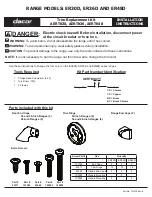
Pag.
42
/
76
§
The Building Standards Regulations, 1981
For others countries the follow appropriate local rules should be oberved:
§
Building regulations and fire prevention provisions
§
Current safety regulations
§
Electrical supply company provisions
§
Current electrical regulations
Fire authority provisions
§
.
INSTALLATION
Preliminary steps
Remove the appliance from the packaging, ensure that it is intact and, if in doubt, do not use it but
contact professionally qualified personnel. The packaging materials are compliant with environmental
safety regulations. They can be stored without risk, or else should be disposed of in accordance with
current national regulations, particularly those regarding the nylon bag and the polystyrene.
After verifying that the appliance is in good conditions, the protective film may be removed. Clean
the external parts of the appliance carefully with warm water and detergent, using a cloth to remove
all remaining residues and then dry it with a soft cloth. If there are still traces of glue, these can be
removed using a suitable solvent (e.g. acetone). Under no circumstances should abrasive substances
be used. After the installation the appliance should be levelled by lowering or raising the adjustable
legs.
Electric connection
Before connecting the appliance, it should be checked to ensure that it is set for the same voltage as
that of the available power supply. If it is not, then the connection should be adjusted, as shown in
the electrical diagram, where voltage conversion is provided for. Depending on the version, the
terminal boards are situated either behind the top control panel or behind the oven control panel (1);
the latter (fig. 23 & 24 p. 9) can be accessed by loosening the two screws holding the support (2) (if
present) and removing it together with the terminal board, having first fed the cable through the
cable gland (4). It is also necessary to check that the appliance is properly earthed, that the earth
wire on the connecting side is longer than the other wires and that the connecting cable is of a
sufficient diameter for the power consumed by the appliance, at least H05 RN-F.
In accordance
with international requirements, an omnipolar isolating switch with a minimum contact
opening of 3 mm, which must not interrupt the green-yellow earth cable, should be installed
upstream from the appliance.
The switch should be installed near the appliance, it must be
approved, and should have a sufficient capacity for the consumption of the appliance (see technical
features).
The appliance must be connected to the EQUIPOTENTIAL system. The connector is situated near
the entry point of the electric cable and is identified by a label with the symbol shown in fig. 13 (p.
7).
When using a safety switch for fault currents, the following should be observed:
-
According to current legislation, these kind of appliances can have a leakage current of 1mA
per kW of rated power input with no maximum. It should also be noted that all fault current
protection switches available on the market have a current tolerance of less than 50%;
therefore, a suitable switch should be chosen.
















































